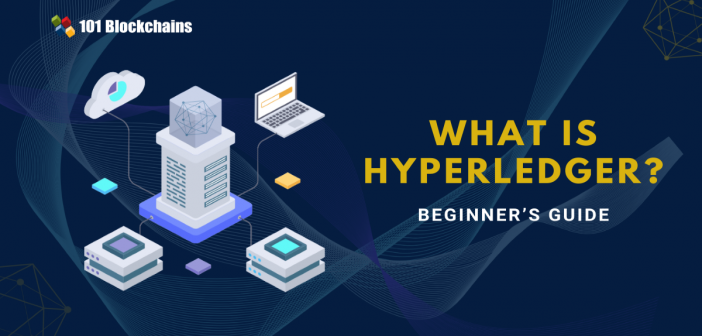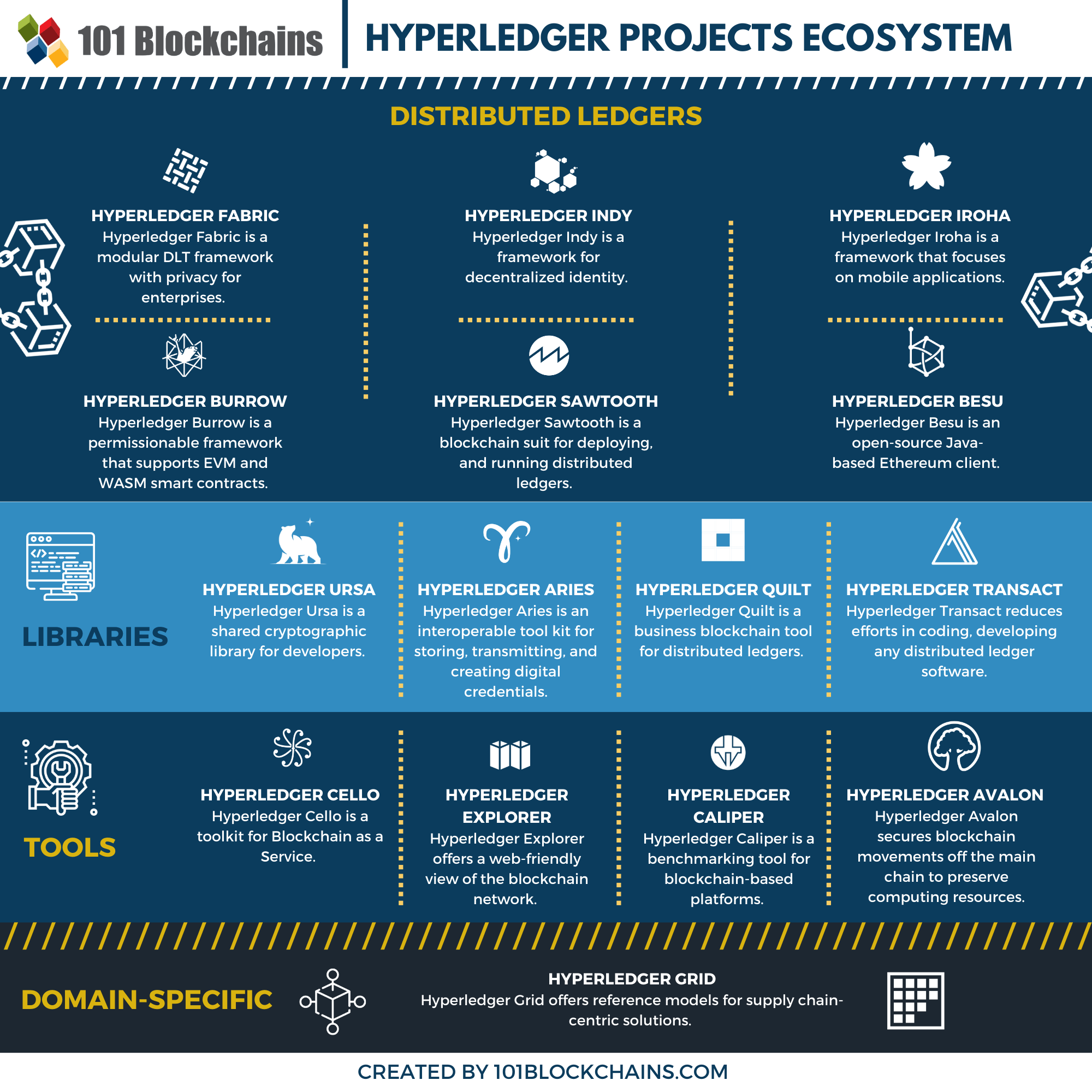Learn how blockchain truly works, master key definitions, and uncover what makes smart contracts so "smart." Dive into the fundamentals, gain valuable insights, and start your blockchain journey today!

- Guides
101 Blockchains
- on June 04, 2021
What is Hyperledger? Beginner’s Guide
The following discussion will focus on what Hyperledger is, the purpose of the initiative, and different Hyperledger projects.
In the age of blockchain, it is common to see new players. And, you would not find it hard to digest that even Linux Foundation is interested in the blockchain. Well, Linux Foundation released their Hyperledger project that focuses on blockchain.
But, don’t be mistaken. It is neither a blockchain nor a company or a cryptocurrency. So, what is Hyperledger? Hyperledger is an open-source collaborative effort to make blockchain technologies advance. It is also having a cross-industry reach and is not committed to just one single industry or vertical.
Linux Foundation was established in 2016 and has already garnered more than 250+ members. Technological, financial, and blockchain startups are part of the whole Hyperledger ecosystem. All these are innovative companies or startups and help Hyperledger reach its true potential. So, what exactly is Hyperledger?
Want to learn the basic and advanced concepts of Blockchain and Hyperledger Fabric? Enroll Now: Getting Started with Hyperledger Fabric Course
What is Hyperledger?
As we already discussed, Hyperledger is an open-source collaborative effort for the betterment of the blockchain. It acts as a hub for the Hyperledger projects that drive towards a common goal. This collaborative approach will bring blockchain adoption to a new height.
Unlike other platforms like Ethereum, which focuses on the public implementation of blockchain, Hyperledger is more geared towards enterprises. Therefore, as enterprises are keener to use blockchain in a more private setting thus, most of the Hyperledger projects are permissioned. Although Enterprise Ethereum now offers a permissioned option as well. Anyhow, one of their most prominent solutions is Hyperledger Fabric.
Curious about the differences between Hyperledger Fabric and Ethereum? Here’s a comparison guide to Ethereum vs Hyperledger Fabric that you should check out.
Does It Have Its Own Token?
One of the common questions asked by cryptocurrency community members is whether Hyperledger will have its own token? The answer is no. There is no intention to have any form of digital currency attached with Hyperledger. All the Hyperledger development is more focused on the development of various blockchain technology. It does not and will not focus on any token-based economy.
However, the projects offer options to integrate blockchain in payment or token economy integration as many solutions may want a native currency within the network. But you will not need any type of token to use the platforms whatsoever.
Build your identity as a certified blockchain expert with 101 Blockchains’ Blockchain Certifications designed to provide enhanced career prospects.
Hyperledger Focuses on Enterprise-Grade Framework
They are trying to build open-source enterprise blockchain frameworks. The frameworks are meant for distributed networks and will have a codebase attached to them. Also, you can use the framework to maintain, create and promote open infrastructure. All of the Hyperledger development is open to use for anyone, so there aren’t any issues like vendor restrictions.
Want to develop expertise in Ethereum? Enroll Now: The Complete Ethereum Technology Course
Which Projects Are Running Under Hyperledger?
There are plenty of Hyperledger projects that are currently running under Hyperledger.
Please include attribution to 101blockchains.com with this graphic. <a href='https://101blockchains.com/blockchain-infographics/'> <img src='https://101blockchains.com/wp-content/uploads/2020/01/Hyperledger-Projects.png' alt='Hyperledger Projects='0' /> </a>
Distributed Ledgers
Burrow: The project uses permissioned smart contracts through a modular blockchain client. It uses Ethereum Virtual Machine (EVM) style.
Sawtooth: Hyperledger Sawtooth is a platform through which anyone can build scalable distributed ledgers. Hyperledger Sawtooth is also used to deploy and run them.
Indy: Hyperledger Indy is another distributed ledger project meant to provide libraries, tools, and other reusable components. The mission of the project is to provide a means to create and use digital identities that are independent and decentralized.
Iroha: Iroha is specifically for blockchain and IoT developments. It offers a simple yet modular infrastructure that includes YAC consensus algorithm.
Besu: Hyperledger Besu is actually an Ethereum client that can be used in both private and public solutions. More so, it also uses several types of consensus algorithms for the sake of modularity.
Fabric: Hyperledger Fabric project aims to provide tools required to develop blockchain solutions or applications. Hyperledger fabric is led by IBM and offers a plug-and-play implementation for blockchain.
Want to learn the difference between fabric and sawtooth? Read here for Hyperledger Fabric Vs Sawtooth Vs Composer
Domain-specific
Grid: Grid mainly offers a reference model for supply chain industries. In reality, this model will deal with supply chain-based data models, data types, and smart contracts.
Libraries
Aries: Aries is a library tool for sharing, reusing, and interoperating solutions that deal with digital credentials.
Quilt: Quilt is a variation of the Interledger protocol implemented with Java. More so, it also enables payment networks that use crypto or fiat money.
Transact: Transact offers a simpler approach to distributed ledger application deployment. Using this, developers can save time and effort in developing a new type of ledger. It offers a standard interface that includes a smart contract integration.
Ursa: Ursa is another type of library that stores different cryptographic approaches. More so, it’s a shared library that helps in avoiding duplication of similar cryptographic methods.
Tools
Avalon: Avalon is an independent implementation of Enterprise Ethereum Alliance. It helps to process computing resources off the chain and offers computational trust.
Cactus: Hyperledger Cactus is a unique kind of tool that helps developers to integrate any kind of blockchain into their systems.
Caliper: If you want a benchmarking that can measure the efficiency or performance level of your solution, then Caliper is the way to go. In reality, it will help you to determine whether your solution is up to the standards or not.
Cello: Cello is a management tool for blockchain. More so, it helps to create, use or manage the blockchain by creating a dashboard for the users.
Explorer: It’s a web application tool that one can use for viewing, deploying, invoking, or querying any block within the network.
Not sure how to build your career in enterprise blockchains? Enroll Now in How to Build Your Career in Enterprise Blockchains Course
What’s Next?
This is just a start for Hyperledger. It is one kind of blockchain collaboration that aims to make blockchain more accessible to everything. They are working on multiple frameworks which are led by the world’s best companies and startups. There are already many existing Hyperledger use cases that are working perfectly without any issues.
Not only that, but they are also developing various tools that will make accessing and managing blockchain much easier. The best part about Hyperledger is how they are building the best tools and framework without any monetary engagement. They are open source and provide the best tools that blockchain can ever have. Also, this will make blockchain more accessible. If you are eager to learn more about Hyperledger, then enroll in our getting started with Hyperledger fabric course now.
*Disclaimer: The article should not be taken as, and is not intended to provide any investment advice. Claims made in this article do not constitute investment advice and should not be taken as such. 101 Blockchains shall not be responsible for any loss sustained by any person who relies on this article. Do your own research!






